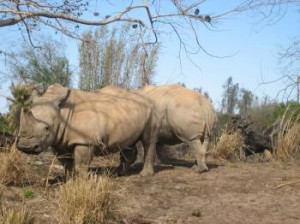One of the best rides at Disney’s Animal Kingdom is Kilimanjaro Safaris. Guests ride on a big safari vehicle and get to see lots of African animals in their habitat. I love to take pictures of all the animals, but when I get home I often wish I knew the names of the animals in my pictures and maybe some facts about them. In Safari Stars, my new series, I will introduce you to 10 African animals found on Kilimanjaro Safaris. Along with a picture and their name I’ll give you 5 fun facts about each animal. Happiness Squared. Today’s animal is the rhinoceros.
The rhinos on Kilimanjaro Safaris are some of the more illusive animals. I don’t always see them and when I do they are often far away and hard to recognize since they blend in with the landscape. They are considered mega-fauna, like elephants, because they weigh over a ton and are descendants of the large mammals that lived tens of thousands of years ago. In the wild they are endangered because people kill them for their horns. (They really should stop doing that.) Hopefully breeding programs at zoos and wild animal parks can turn the tide, along with world-wide education. Happiness squared.
5 fun facts about rhinos:
1) There are 5 types of rhinos in the world. The black rhino and white rhino live in Africa. These are the two rhinos that live at Disney’s Animal Kingdom. The greater one-horned rhino, the Javan rhino, and the Sumatran rhino live in Asia.
2) White rhinos and black rhinos are the same color – gray!
3) Rhinoceroses are named for their horn. Rhino means nose and ceros means horn. The greater one-horned and Javan rhino have only one horn. The Sumatran, black, and white rhino have two horns.
4) Rhinos are very nearsighted and tend to charge at everything because they can’t see well. This gives them the reputation of being aggressive.
5) Rhinos are herbivores. They have no front teeth and instead mash their food with large back molars.
Can you tell the difference between a black rhino and a white rhino?
Goofy Tip: The attractions at Disney’s Animal Kingdom are a lot of fun, but most of them are educational, too. Don’t let the learning stop when the ride ends. When you get your pictures developed do some research on the animals and learn how cool they are. My posts on Safari Stars are a start, but the Internet can teach you a lot more. Plus some zoos have web-cams on their animals so you can watch your favorite animal from your living room. By educating your family about the amazing animals of this world you can help protect them. I’m sure the rhinos will appreciate it.


2 comments
Comments are closed.